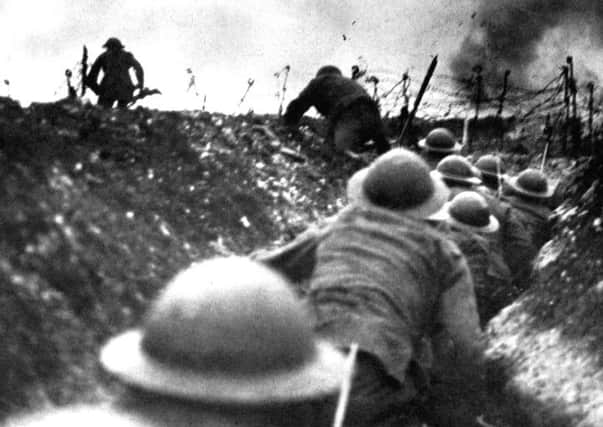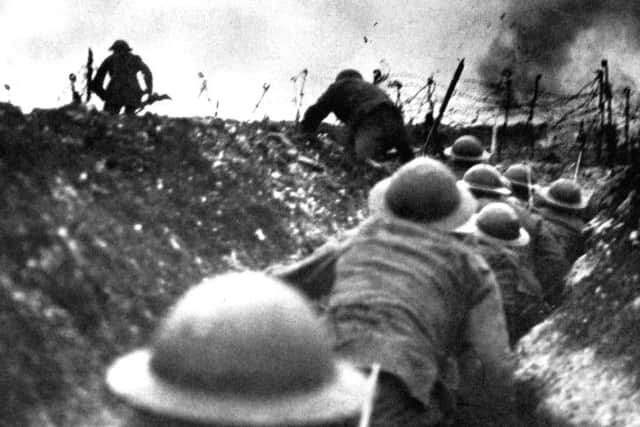Malcolm Barker: When the lights went out in Europe


He may well have reflected the German attitude too, for both were Christian nations then, although that did not deter them from spending the next 51 months seeking to slaughter each other’s menfolk, and, in the case of Germany, any small nation that got in the way.
As Sir Winston Churchill wrote: “Torture and cannibalism were the only two expedients that the civilised, scientific, Christian states had been able to deny themselves, and these were of doubtful utility.”
Advertisement
Hide AdAdvertisement
Hide AdThankfully, the future was veiled for those who took to the streets in wild excitement to celebrate the declaration of war by Great Britain and her Empire, an anniversary the Royal British Legion is hoping people will mark on Monday by turning out their lights at 10pm and lighting candles.


Not all joined in the general rejoicing. The Foreign Secretary, Sir Edward Grey (later Viscount Grey of Falloden), declared: “The lamps are going out all over Europe; we shall not see them lit again in our lifetime.” It is this forecast that inspired the British Legion’s call for an hour’s blackout on Monday evening.
The reality of war soon set in. On August 6, 1914, the cruiser HMS Amphion sank after striking a mine in the English Channel, with the loss of 160 lives.
These were the first fatalities in a conflict that eventually cost the British Empire 947,023 dead or missing.
Advertisement
Hide AdAdvertisement
Hide AdThe atmosphere of those early days is featured in an exhibition, “1914 & Whitby”, assembled by Roger Dalladay at the town’s museum in Pannett Park.
Mr Dalladay has done a remarkable job, demonstrating how the onrush of world events affected a small town on the shore of what was then known as the German Ocean.
Three days after the Amphion disaster had demonstrated that the Royal Navy was not invulnerable, thousands of townsfolk gathered in Whitby to say farewell to 39 Naval reservists who had been called to the colours. There were tumultuous scenes, with drums beating, trumpets blowing, and cries of “God save the King” as the men marched to the railway station.
By September 22 seven of them were dead, lost off the Dutch coast when the obsolete cruiser HMS Hogue, on which they were serving, was sunk by the German U-boat U9, along with her equally ancient companions, HMS Aboukir and HMS Cressy.
Advertisement
Hide AdAdvertisement
Hide AdWhitby’s doubts about the Royal Navy intensified in December when the German battle-cruisers Derfflinger and Seydlitz shelled the town. They blew a leg off a Boy Scout, and killed a coastguard, an elderly lady who was in bed, and William Edward Tunmore, a North Eastern Railway drayman, who was seeking to get his horse out of the line of fire when he was hit. He and his wife and their four children lived in Gray Street, Fishburn Park, and Mr Tunmore was a warden at St John’s Church in Baxtergate.
Back in August, there had been a sub-plot to the general euphoria. It was spy mania, eloquently illustrated by Mr Dalladay with an extract from the Whitby Gazette: “A German spy passed through Whitby on a motor-bicycle at six o’clock on Wednesday morning, riding hard. He took the Guisborough high road.”
The paper added that Boy Scouts could be deployed to identify spies, and added this advice: “If they can’t say ‘th’ correctly in all probability they will be Germans.”
While Whitby was getting on a war footing, events in London and France were proceeding apace. Two men who had crucial roles in the eventual outcome of the war were in the Cabinet. One was the 1st Viscount Haldane who, as Richard Haldane, had served as Secretary of State for War in 1905-12. His Army reforms proved their worth in 1914. As John Strawson wrote in his book, Gentlemen in Khaki and Camouflage (Pen and Sword Books, 1989): “In 1914 when the mobilisation of the Army was actually ordered, the whole machine worked perfectly. The regular divisions were sent to France in two weeks.”
Advertisement
Hide AdAdvertisement
Hide AdIn addition, 14 Divisions of Haldane’s Territorial Force (later the Territorial Army) were ready for home defence, with many eager to volunteer to serve abroad. Before the end of the year, a Territorial battalion of the London Scottish had joined the regulars in the defence of Messines Ridge, near Ypres. Haldane’s contribution, Mr Strawson asserted, had been “incalculable”.
The other important figure in the early days was Lord Kitchener, who was persuaded with some difficulty by Prime Minister Asquith to become Secretary of State for War. Kitchener did not believe hostilities would be over by Christmas. Within two days he secured Parliamentary approval for an initial increase of a million men to the Army’s strength. The response to his recruiting poster, with pointing right index finger and steady gaze, astonished him.
Kitchener had studied the German Schlieffen Plan, which envisaged an attack through Belgium, and the fall of France with 40 days. The British Expeditionary Force, small but superbly trained and well-equipped, helped thwart that scheme, the “Old Contemptibles”, as they styled themselves, being almost wiped out in the process. The war was at stalemate, and the trench lines spread from the sea to Switzerland.
And so it remained, at appalling cost, for nearly another four years.
Advertisement
Hide AdAdvertisement
Hide AdAt Whitby Museum’s exhibition, dozens of anxious faces stare from the walls: people like Harold Chapman, who came back from Canada to enlist, and was killed, aged 40, in 1917; Mrs Stevenson of Salt Pan Well Steps, who had six sons in uniform; James Noble, a railway platelayer whose four grandsons returned from abroad to fight; Mr Tunmore; the seven lads off Hogue.
I experienced a mad wish to tell those who did not return, “We won! We won in the end.” Amid the remembrance, surely some triumphalism may be permitted?
There will be a special opening of Mr Dalladay’s exhibition at the Pannett Park Museum, Whitby, on Monday, August 18 (2.30 to 7pm). Admission free.
• Malcolm Barker is a former editor of the Yorkshire Evening Post.